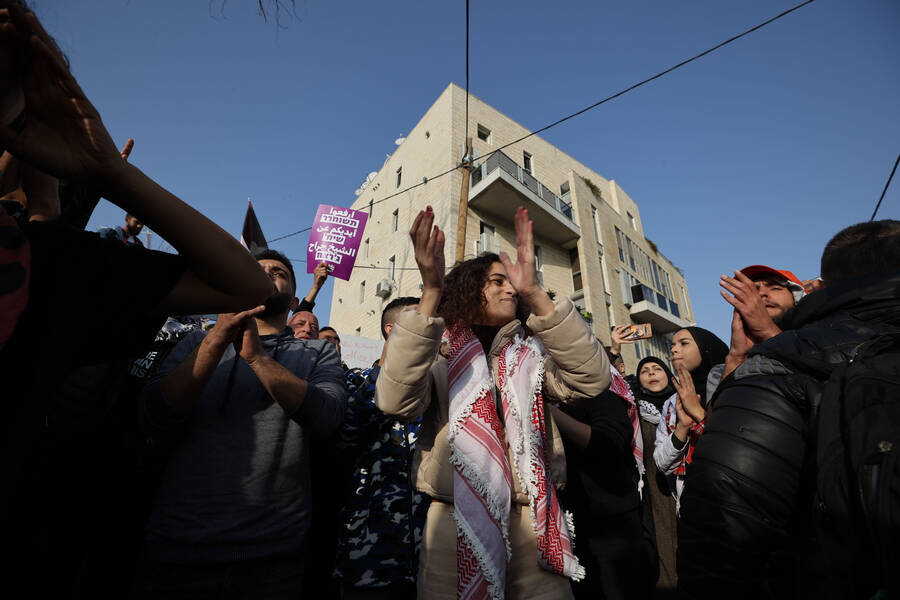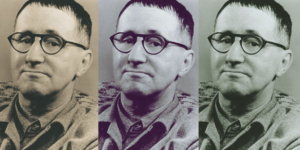In 2021, Mohammed El-Kurd, a Palestinian writer from Sheikh Jarrah in East Jerusalem, published a poetry collection, Rifqa. The poem, “Fifteen-Year Old Girl Killed For Attempting to Kill a Soldier (With a Nail File), Or Context,” captures a theme that animates newer generations of the movement for Palestine’s liberation. It is an angry rejection of the apologia and destructiveness of the Declaration of Principles on Interim Self-Government Arrangements (Oslo Accords), which were officially signed into law in 1995 and created the Palestinian Authority (but not a Palestinian state).
“Running to catastrophe with context, / commissioning compassion, turning / heroes into humans,” El-Kurd writes, “This is a refuted revolution.” The poem continues, in a modified refrain, “Solidarity often is a refuted revolution.”
The poem’s accomplishment lies in its ability to relay the inherent injustice that the West inflicts on Palestinians, telling us to make our anti-colonial struggle more “palatable” by presenting what Dalya Al Masri terms “the perfect Palestinian victim: innocent but not defiant.” She writes, “This is the same dialogue that created the Oslo Accords and the subcontractor of Israeli occupation, the Palestinian Authority. It also reinforces the both-sides narrative popular in the West that helps legitimize violence against Palestinians.”
As El-Kurd invokes, a revolution is “refuted” when the people’s resistance is framed as inherently unethical. “Running to catastrophe with context” invokes the constant need to justify our struggle — using the proper deferential tone — while our very existence is under attack.
We are seeing a growing rejection of that political etiquette critiqued by El-Kurd. The post-Oslo generation seeks to forge a new path to liberation, one that avoids the destruction the “peace process” left behind in the 1990s.
When political commentators refer vaguely to the peace process or the “two-state solution,” they are talking about the Oslo framework initiated when the Palestinian Liberation Organization (PLO) began negotiations with Israeli officials after the 1987 – 1993 Intifada (or Palestinian uprising) that garnered global attention. Prior to this moment, armed resistance was standard in the Palestinian liberation movement, which had realized its modern incarnation in the late 1960s. It was part and parcel of the broader rise of anti-colonial liberation causes that swept the globe after World War II, a history which gives coherence to the ultimatum PLO leader Yasser Arafat posed to the United Nations in 1974: “Today I have come bearing an olive branch and a freedom fighter’s gun… Do not let the olive branch fall from my hand.”
In 1991, the United States facilitated a series of negotiations between Israeli and Palestinian representatives in Madrid. In 1993, the PLO began back-channel negotiations in Oslo, Norway, that would come to supplant the Madrid negotiations, which eventually resulted in the Oslo Accords.
From the outset, Oslo’s terms of engagement were so one-sided that their only immediate effect was to defang Palestinian resistance. “Let us call the agreement by its real name,” Edward Said wrote presciently in 1993, “an instrument of Palestinian surrender, a Palestinian Versailles.” Said had resigned from the Palestine National Council in 1991 in protest.
Under Oslo’s terms, the Palestinian resistance would lay down its arms in exchange for the mere promise of a future state. The agreement also abandoned the right of return, effectively excluding millions of Palestinian refugees and exiles the world over from inclusion in that theoretical future state. The deal also divided Palestinians from one another by introducing a cruel, geography-based calculus of who did and did not have claim to the state. Previously, one of the tenets of the modern Palestinian liberation movement — from the 1960s up to just before the initiation of the Oslo process — had been that all Palestinians, whether facing occupation in Palestine or banished into exile, had the right and duty to fight for a future liberated homeland; the Oslo Accords betrayed this principle by closing off the question of Palestine only to those Palestinians on the “inside.”
The agreement introduced even more geographic fragmentation onto Palestinian lands by dividing the West Bank into three administrative areas — A, B and C. The goal was, ostensibly, to split up ownership and management of the areas, but in reality it fragmented Palestinian society and ensured Israel’s economic and political control of the West Bank.
Here’s how Palestinian activist Jamal Juma’ describes these areas: “In essence, the Oslo agreements were the blueprint for a ‘Bantustan solution’ to the Palestinian issue. Israel saw the agreement’s classification of West Bank land into Areas A, B and C as a tool for gradual annexation.”
As the American Friends Service Committee explains, “Area C, which comprises 61% of the West Bank, is under the full control of Israel through the Civil (Military) Administration in the West Bank. Area B, 22% of the West Bank, is under the full administrative control of the Palestinian Authority but under the military control of Israel. Area A makes up 17% of the West Bank and is under full Palestinian control.”
While Oslo officially created the Palestinian Authority as an interim body meant to facilitate the gradual transition toward an independent Palestinian state, in reality the Palestinian Authority was never fully equipped to do much of anything other than oppress its own people on behalf of Israel. As Palestinian journalist Ramzy Baroud recalls, “The Intifada ended with the rise of the Palestinian Authority in 1994, itself an outcome of secret ‘peace talks’ between Israeli and PLO officials in Oslo. The people were duly suppressed, this time by Israel and the most corrupt element of the Palestinian leadership. A few Palestinians became rich, while others were pushed deeper into despair. The Occupation did not end, but was enhanced by a layer of ‘security coordination,’ managed by Palestinians and Israeli army officers.”
Prior, the Palestinian liberation struggle had been waged with the conviction that any Palestinian, wherever they happened to be, had a direct role to play in the liberation of Palestinian land and people. Resistance could be waged from exile and within refugee camps. But as Mjriam Abu Samra writes, the Oslo Accords “chapterised” the Palestinian liberation struggle, transforming one unified collectivity into a series of discrepant “issues”: “‘the green line’ or a ‘borders issue,’ the ‘Jerusalem issue,’ the ‘Gaza issue,’ the ‘Israeli-Arab citizens issue,’ and the ‘refugee issue,’ just to name a few.”
The liberal negotiations framework that Oslo put into place overwrote prior resistance. Now, the Palestinian struggle was to be approached through the logic of international humanitarianism, with the Palestinian people expected to fill the role of perfect victims — to perform death over and over again as incompetent and uncaring bureaucrats continued to “negotiate” on their behalf. Civil society organizations that once played a crucial role in the liberation struggle were increasingly professionalized and depoliticized for an NGO-administered international aid regime, which shifted the focus from resisting colonial policies to normalizing them.
Ultimately, the Palestinian political apparatus would become an arm of the colonizer, and the Palestinian Authority would go on to torture, incarcerate and police its own people — at Israel’s behest — under a process known as “security coordination.” This dynamic persists today.
On March 6, 2017, Basil al-Araj, a Palestinian intellectual and widely known grassroots youth activist, was killed by the colonial Israeli regime in collaboration with the Palestinian Authority. Notably, the resultant, worldwide actions taken to protest the assassination of al-Araj included messaging that criticized security coordination, an outgrowth of the Oslo framework. Al-Araj’s legacy — and the example set by all who rose up against these unjust policies, including the Palestinian prisoners who bravely launched hunger strikes — reveals that a new generations of Palestinians are rising up in defiance and rejection of the Oslo Accords.
On June 24, 2021, the Palestinian Authority arrested activist Nizar Banat, a long-time critic of the Palestinian Authority’s conduct, and beat him to death. The group Palestinian Lawyers for Justice described it as an “assasination.” The Palestinian Authority’s murder of Banat in turn sparked waves of protest across the West Bank, with protesters calling for justice for Banat and his family as well as the end of the reign of Palestinian Authority President Mahmoud Abbas. The Palestinian Authority naturally suppressed those protests.
But anyone who believed the destructiveness of the Oslo Accords event would mark the end of Palestinian resistance was sorely mistaken. In May 2021, Sheikh Jarrah, the East Jerusalem neighborhood whose Palestinian residents are currently resisting Israeli ethnic cleansing, became a flashpoint for new forms of unified Palestinian resistance. Palestinians from all over rose up in a collective display, known as the “Unity Intifada,” to defy Zionist settler-colonialism and their looming displacement. (Zionism refers to the settler-colonial ideology, established in Europe during the 19th century, which holds that Palestinians must be ethnically cleansed to make way for a demographically “pure” Jewish state.) The “Dignity and Hope Manifesto” issued by these Palestinian resisters proudly asserts, “Palestinians are one people, one society,” a direct challenge to the geographically isolated framework of the Oslo Accords. The document talks of the need for ongoing resistance from all Palestinians — whatever “prison” they happen to be forced into by the Zionist regime — asserting that all Palestinians are a single people united by the ongoing struggle for liberation and the imperative to resist collectively.
The poet Mohammed El-Kurd is from Sheikh Jarrah, and he and his sister, Muna-El Kurd, have been some of the most recognized and active participants within Unity Intifada.
While the uprisings in Sheikh Jarrah first electrified global solidarity in May 2021, popular resistance to looming ethnic cleansing within the occupied East Jerusalem neighborhood continues. Indeed, from Sheikh Jarrah to Gaza to hunger-striking Palestinians within regime jails, Palestinians have risen up in collective resistance, showing that we will not accept the fragmentation of Oslo and that resistance is our duty wherever we find ourselves.
The revolution will be refuted no longer.
(Omar Zahzah is a writer, poet, independent scholar and organizer. Omar is the Education and Advocacy Coordinator for Eyewitness Palestine, as well as a member of the Palestinian Youth Movement (PYM) and the U.S. Campaign for the Cultural and Academic Boycott of Israel. Omar holds a PhD in Comparative Literature from the University of California, Los Angeles. Courtesy: In These Times, an independent, nonprofit magazine dedicated to advancing democracy and economic justice.)




